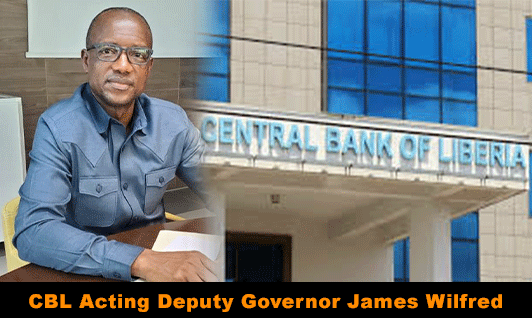The Central Bank of Liberia through its Monetary Policy Committee (MPC) has reduced the Monetary Policy Rate (MPR) from 18.5 percent to 17.0 percent following the final quarterly meeting of 2024 held on October 16.
Speaking with reporters Friday, October 18, 2024 in Monrovia, CBL Acting Deputy Governor James Wilfred said the decision, which comes amid promising macroeconomic indicators, reflects the CBL’s confidence in maintaining a stable exchange rate and moderating inflation as the country heads into the final quarter of 2024. Wilfred also outlined MPC assessment of current economic conditions and announced key monetary policy actions for the upcoming quarter.
He said the MPC’s assessment states that the global economy has shown resilience despite ongoing challenges, including supply chain disruptions, the lingering effects of the Covid pandemic and geopolitical conflicts like the Russia-Ukraine war and the Israel-Hamas crisis.
“Despite these headwinds, the global economy managed to avoid a recession in 2023, achieving a real GDP growth of 3.3%. While the 2024 growth projection of 3.2% is slightly lower, the outlook remains optimistic,” he said.
The CBL Acting Deputy Governor said the committee highlighted the role of tight monetary policies in moderating inflation globally, pointing to a decrease in global headline inflation from 6.7% in 2023 to a projected 5.9% for 2024. He said inflation remains elevated in several low-income countries, particularly in Sub-Saharan Africa where inflation is expected to moderate to 15.3%, down from 16.2% in 2023.
In terms of commodities, Wilfred said the MPC observed rising prices for cocoa, palm oil, and gold, while prices for rice, coffee, iron ore, and petroleum declined; the drop in petroleum prices was noted as a positive factor helping to improve Liberia’s trade deficit during the quarter.
He said on the domestic front, Liberia’s economic performance showed slight improvements in the third quarter of 2024. The country’s Quarterly Real GDP (QRGDP) grew by 1.3%, reversing the contraction recorded in the previous quarter; stating, the MPC attributed this to a moderation in consumer prices and an increase in consumption
“We are optimistic that economic activity will strengthen further in the final quarter of the year, driven by increased consumption and government fiscal spending,” Deputy Governor Wilfred said.
Wilfred: “Inflation in Liberia also showed signs of improvement, with the MPC reporting a decline from 7.4% in the second quarter to 6.8% in the third quarter. The Committee expects inflation to further ease to 6.4% by the end of the year, citing improvements in food prices and the CBL’s monetary policy stance.”
He said despite these positive developments, the MPC expressed concern over the performance of Liberia’s banking sector. While total loans and advances grew by 1.2%, other key financial indicators, including total assets, deposits, and capital, all declined during the third quarter.
The Committee also noted an increase in non-performing loans (NPLs), which rose by 1.79 percentage points. “Loans and advances remain highly concentrated in five sectors: trade, personal loans, services, oil & gas, and construction, with these sectors also accounting for the highest share of non-performing loans. We are concerned about the low level of lending to the agriculture and manufacturing sectors,” Wilfred said.
The Acting CBL Deputy Governor said that the Committee also reported slight declines in Liberia’s monetary aggregates during the third quarter, with broad money (M2) contracting by 1.6%; the currency in circulation also saw a marginal decline. However, CBL bills activity in the financial markets showed positive growth with total subscriptions increasing by 24.8%.
“The total subscriptions to CBL bills by commercial banks and retail investors grew by 25% and 19%, respectively,” the MPC noted, adding that the absence of government Treasury bill activity poses a risk to financial market development,” Wilfred said.
By Prince Saah



